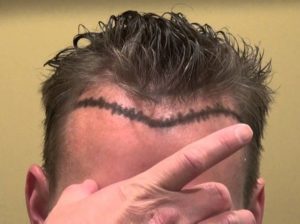 Hair transplant for receding hairline – All hair restoration procedures involve an initial consultation in which the surgeon – together with the patient – will evaluate and discuss the needs and expectations of the patient, will draw up a treatment plan and will choose the hair transplant procedure most suitable for the particular needs of the patient.
Hair transplant for receding hairline – All hair restoration procedures involve an initial consultation in which the surgeon – together with the patient – will evaluate and discuss the needs and expectations of the patient, will draw up a treatment plan and will choose the hair transplant procedure most suitable for the particular needs of the patient.
Agreeing on a certain hairline design is also an important part of this initial discussion. Whether it’s a high density low hairline the patient is after or a mature hairline, the hair surgeon must be able to deliver natural-looking results.
Why is hairline design so important?
The hairline is one of the most important elements of a well-executed hair transplant. It’s the first thing people notice when looking at an individual, and it’s what the individuals themselves notice when they look in the mirror. Designing a perfect hairline means designing one that looks natural and which is in no way a giveaway for a hair transplant. A hair transplant procedure is a meticulous process, and designing a good hairline is nothing short of an art form. The success of a hair transplant is largely influenced by the skill of the hair surgeon. Hair follicles have to be implanted in a certain way, in a certain angle and pattern that closely resembles that of naturally growing hair. If the design of the hairline is too linear, too low or does not reflect the age of the wearer, it will be noticeable without a doubt.
It’s difficult to mimic nature, but a skilled surgeon can design a hairline with all the features that define it.
What is good hairline design hair transplant?
Good hair surgeons will go at great lengths to make sure your hair transplant will result in a look as if it was designed by Mother Nature itself. To this end they will closely examine your hair growth and even hair loss pattern, and ask you to bring in pictures of yourself before your hairline started receding. This will help them get a better idea of how your hair loss progressed and how to go about re-designing your hairline.
There are certain features that any good hairline transplant should have, and these can be summed up as follows:
- A good hairline is age appropriate – if you’re in your 30s and you have minimal hair loss with slightly receding temples, and you’re looking to get your hairline lowered, the hair surgeon will inform you that as you near your 40s, your hair loss will progress and further procedures will become necessary. Likewise, a man in his 40s with a hairline design that looks like that of someone in his 20s will seem unnatural. In this case, a good hairline design should reflect the natural look of the hairline of a man in his 40s who is not balding. This implies that a low hairline with high density would not look natural.
- A good hairline avoids straight lines – it’s also important to avoid placing hair grafts in a straight line. Creating a blend that reflects how hair naturally grows in this area of the head is crucial to the success of the procedure.
- A good hairline will have a feathering zone – this is the transition zone between a bald head and the area with denser hair. This area should be populated with follicular units that contain only one or two hairs, and larger units should be placed behind the feathering zone, where there is thicker hair.
All these aspects should be discussed with your hair surgeon at length. Your hairline is the first thing you’ll notice after your hair transplant, and it will determine your level of satisfaction about the hair transplant in a significant way. Recent drop in hair loss surgery prices and costs enables male patients to undergo hair transplant abroad. More and more men choose Hungary to get a new look and get back their self-esteem.
